How do I load the dishes into the dishwasher correctly?

Installing a dishwasher will make life easier by taking all the work of washing the dishes yourself. When purchasing such an expensive technique, it is worthwhile to study the rules for operating the dishwasher in advance. Most often, problems arise with the loading of dishes, and this is where many mistakes are made.

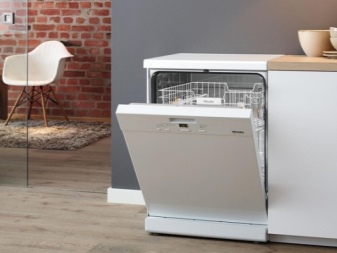
Fundamental rules
The correct loading of the dishes into the dishwasher is ensured by observing the rules.
- The manufacturer's recommendations for maximum load should be followed for each model. Overloading the dishwasher can cause serious damage. High-quality cleaning is only possible if there is space between kitchen items.
- Use only special products for dishwashers.
- Bulky dishes, which does not fit in the machine must be washed by hand.
- Re-washing the dishes is carried out only after cleaning the dishwasher hopper from food debris - this is necessary in order to avoid clogging of the drain hole, which will affect the quality of washing and further disable the equipment.
- Before loading the dishes, remove food residues from them, but it is not worth washing it, because in this case a weak cleaning program will be automatically installed.
- Kitchen utensils are placed upside down. If this is not possible, then at an angle so that dirty water does not accumulate in it.
- Check that the dishes are well fixedotherwise it will turn over under the pressure of the water. Plates are placed in special grids, and glasses are supported by holders.
- In many dishwasher models there is a special mode for cleaning stubborn dirt.
- It is forbidden to put any items in the pillbox.
- The most dirty dishes are placed in the lower basket.
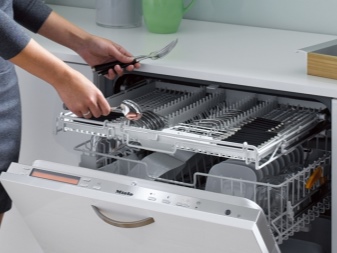
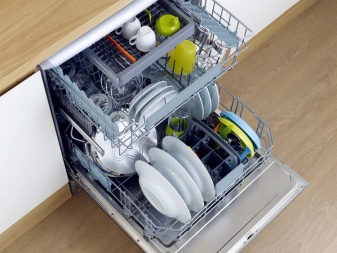
Both narrow (45 centimeters) and full-size (60 centimeters) dishwashers have a second or third load level, each dedicated to a specific dish. Also available:
- a box for plates;
- removable cutlery compartment;
- upper compartment for small items and mugs;
- lower compartment for larger dishes.
In some models, there is another area at the top of the dishwasher - it is a removable flattened tray in which you can put cutlery.

There are separate slots that hold small cups. In some models of dishwashers, there is a function of washing fragile objects (porcelain, crystal), dishes in other sections are washed under the pressure of hot water.
Each dishwasher is equipped with a stable positioning device. The standard ones include:
- shelf for long items;
- foldable pins to hold the baking sheet;
- small object holders.
In addition, you can purchase and install a holder for bottles and tall glasses, an additional basket for dishes and other accessories.
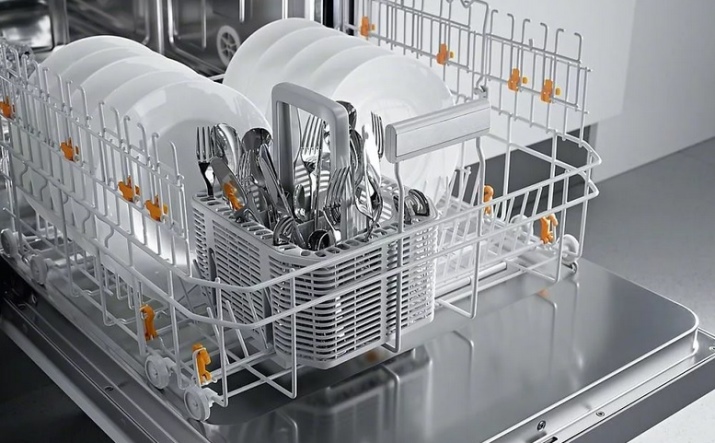
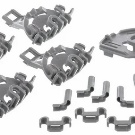
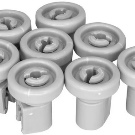
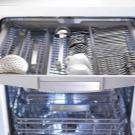


Preparation
After purchasing the dishwasher, you must read the operating instructions and carry out a test run. The dishwasher is checked on a cycle at the maximum temperature with no dishes in the basket.
Test run goals:
- cleaning the dishwasher from lubricants, debris, dust and stains;
- checking for defects in technology;
- control of the correctness of installation, connection to water supply and sewerage;
- study of the features of the work of a particular model.
For the first start, you will need to purchase detergent, salt and rinse aid.

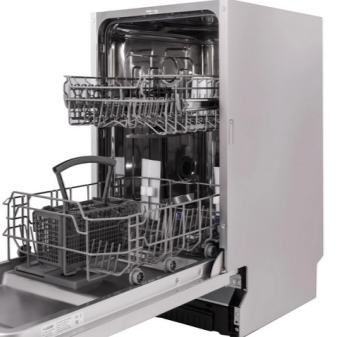
Instruction.
- Step 1. Inspect the dishwasher and make sure there is no damage or foreign objects in the chamber, remove the foam sealing inserts.
- Step 2... Connect the dishwasher to the mains, unscrew the valve that blocks the water.
- Step 3. Check that the machine is installed evenly and in accordance with all the rules of arrangement: at a distance of at least 15 cm from the refrigerator and gas stove, tightly fixed between the cabinets, ideally near the sink.
- Step 4. Connect the supply and return hoses, make sure the joints are tight.
- Step 5. Open the chamber door and rotate the sprayer several times to make sure it can rotate freely.
- Step 6. Unscrew the drain filter, rinse and reinstall.
- Step 7. Add salt, detergent and rinse aid, set the machine to the longest wash cycle.
- Step 8. Close the door tightly, start the dishwasher and observe the following processes:
- water supply;
- heat;
- drain;
- drying.
Only if there are no complaints about functionality can you start full-fledged operation - it is advisable to do this a couple of hours after the end of the test run.
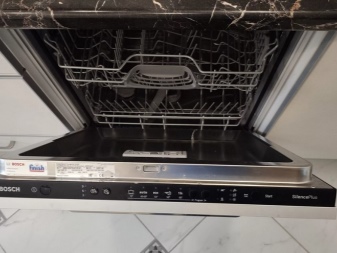
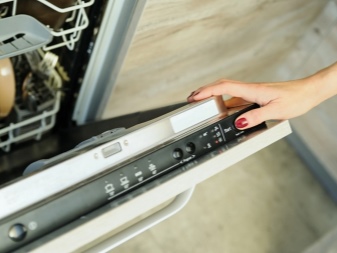
Preparation for the first working start begins with the selection of household chemicals. It is necessary to focus on the form of release (powders, tablets, gels), composition, safety and price. You should also purchase water softeners, descaler and rinse aids.
The following means are used for refueling:
- various gels, powders, capsules, tablets - they are intended for washing dishes;
- salt - reduces water hardness;
- rinse aid - makes the dishes shine and helps to remove streaks;
- degreaser - eliminates greasy deposits;
- anti-scale - combats limescale.
There is a special dispenser for detergents and tablets in the dishwasher, there is a compartment for rinse aid, and a compartment for salt at the bottom of the chamber.
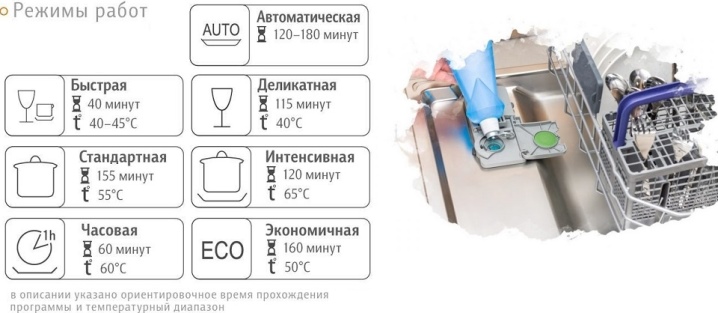
Only after you have decided on the type of funds, you can download the basket and proceed to the selection of a suitable program. The following stages are distinguished in dishwashing.
- Loading dishes. Before refueling the machine, it is necessary to clean off food debris from the dishes - this is done with a sponge or special silicone spatulas.
- Deposit and mode selection (each model can have from 3 to 12 modes, the choice of which depends on the material of the dishes and the type of contamination).
- Soaking dishes in cold water if necessary... This function is not available in all dishwashers, but it is better to take the time and lightly clean the dishes of dried food than to start the machine because of several appliances right after a meal.
- Washing.
- Rinsing. The dishes must be rinsed with detergent.
- Drying.

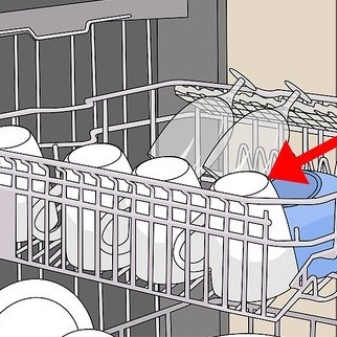
It is important not to open the door during the cycle. Most dishwashers do not allow you to do this until the end of the dishwashing process - this function allows you to avoid scalding by the steam.
The first batch of dishes should be inspected after washing. If there are traces of dirt, you will need to change the mode or detergent, if there are streaks - increase the amount of rinse aid.
It is important to wipe the seals located on the dishwasher door with wet wipes with the addition of detergent before each dishwashing, and then ventilate the box. It is recommended to clean the filters and spray arms every 3 cycles. Once every 2 months - run programs with a long duration.
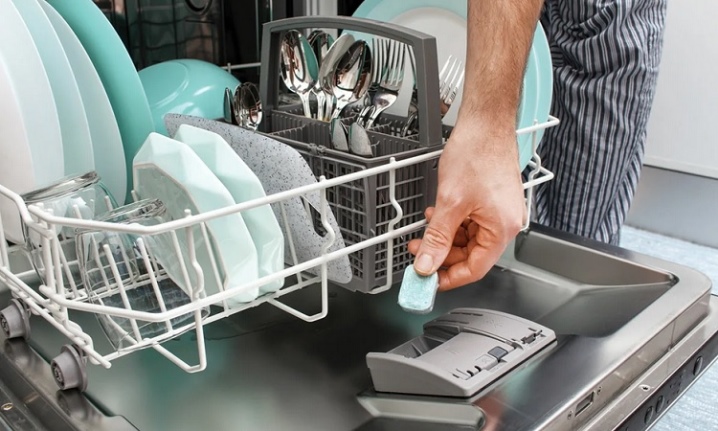
How do I load different dishes?
All 3 levels - upper, lower and removable trays are intended for different types of dishes, but in general the scheme is the same.
When loading dishes, the following nuances should be taken into account:
- there should be space between the dishes, only then the washing will be of high quality;
- the dishes must be washed immediately after eating, removing food debris - this will save water and detergent;
- heavy metal kitchen utensils and fragile items should not be placed side by side;
- the number of cookware sets loaded must comply with the manufacturer's recommendations.
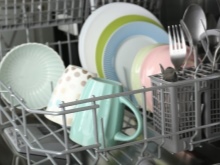
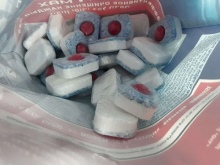
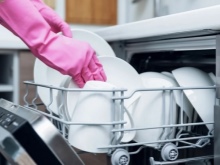
Mugs, glasses, forks, spoons
A removable tray or basket is installed in the machine for cutlery. Forks and spoons should be placed with the handle down. Ladles, shovels and other kitchen utensils are placed in the same compartment. It is not recommended to wash small parts of the dishes and knives in the dishwasher - the former can fall into the holes of the container, while the latter can become dull.
Drink dishes should be placed on the top shelf as they are cleaner than pots and plates and are more fragile. Cups and glasses are turned upside down and stacked at a slight angle, glasses are attached using holders - if they are not there, it is better to wash glasses by hand.
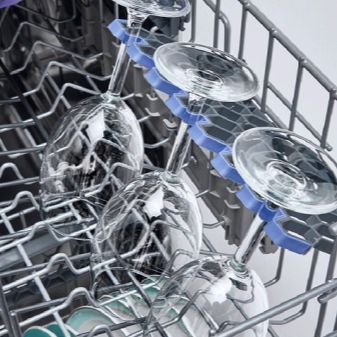
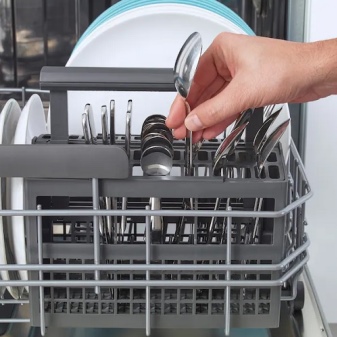
Plates, bowls
Plates of any depth and size can be laid out only vertically, upside down. Flat plates and saucers are placed on the middle tier, deep containers, tureens, bowls and salad bowls - on the lower tier. Cookware with a smaller diameter is stacked closer to the center.
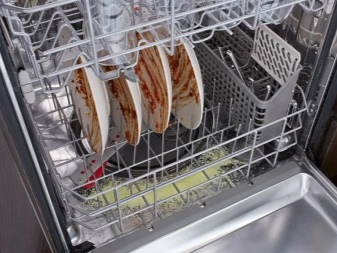
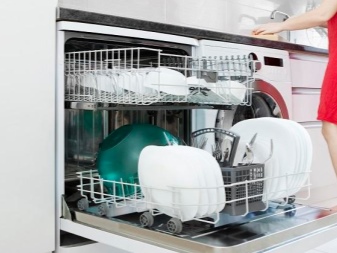
Frying pans, pots
Such bulky dishes must be placed upside down on the lower tier. Place pans and pots at an angle if universal holders are available. Washing pans is a major problem in a dishwasher. Removable handles can be folded along the sides of the lower compartment. If there is a non-stick coating, make sure that the holders do not touch the bottom of the pan and that the temperature is not high.
After the end of the washing cycle, leave the dishes for a while and let them cool down. Ceramic and glass objects can crack in the event of sudden changes in temperature. You should first get the dishes from the lower tier, and then from the upper one.
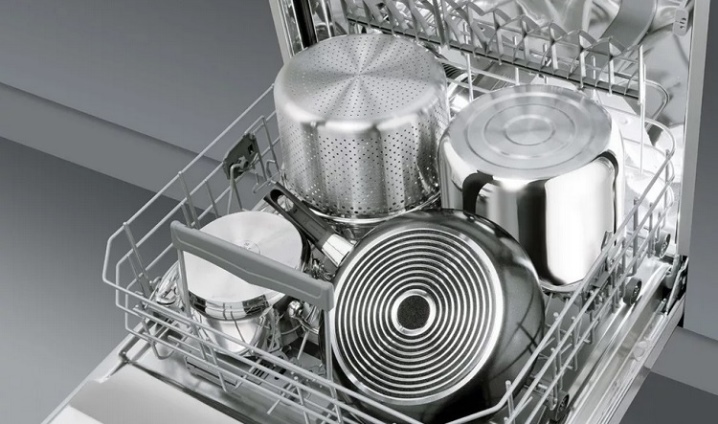
What cannot be put in the car?
Not all dishes can be washed in the dishwasher, because the utensils may not withstand cleaning with hot water, steam and household chemicals. Before starting the process, it is necessary to inspect the dishes - they must be marked with permission to wash in the dishwasher.
Material restrictions.
- Wood... Prolonged contact with hot water, which usually happens in a dishwasher, causes the wood to swell. This leads to deformation of the dishes and to the appearance of cracks on the surface.
- Plastic... Not all plastic containers are dishwasher safe as they can melt when exposed to high temperatures. Only heat-resistant plastic will withstand 2-3 hours in hot water, but even it is not recommended to place it near the heating element, which is located in the lower compartment.
- Metal... Aluminum, silver, copper, or pewter cookware can oxidize and darken. Brass and bronze items also lose their shine due to the action of detergents.
- Non-stick coating... It loses its properties when washed with special dishwasher detergents.
- Porcelain... Hot water cracks on porcelain dishes. If there is a drawing on the porcelain, you can say goodbye to it, it will first fade, and then it will be completely erased. At low temperatures and in the Delicate wash mode, there is a possibility that the product will remain in order.
- Crystal... Crystal glassware is not afraid of high temperatures, but of their changes. Valuable items should be washed by hand.
- Cast iron products. It is forbidden to wash cast-iron dishes without a protective layer, as it becomes covered with a corrosive coating.
- Clay dishes. Clay microparticles will clog filters if the dishes are not covered with glaze.



It is not recommended to wash:
- items soiled with wax, paint and other non-food contamination, as particles can clog the drain hole;
- utensils with blades, as they can become dull;
- vacuum containers - under the influence of hot steam and water, the rubber seal is stretched;
- utensils decorated with painting or gilding - it can wash off;
- fragile items if there is no special function in the dishwasher;
- thermoses, as damage to the thermal insulation layer is possible;
- products with labelsthat can fall off during the washing process;
- towels, sponges and potholders;
- pet bowls;
- sieves and graters;
- small accessories.
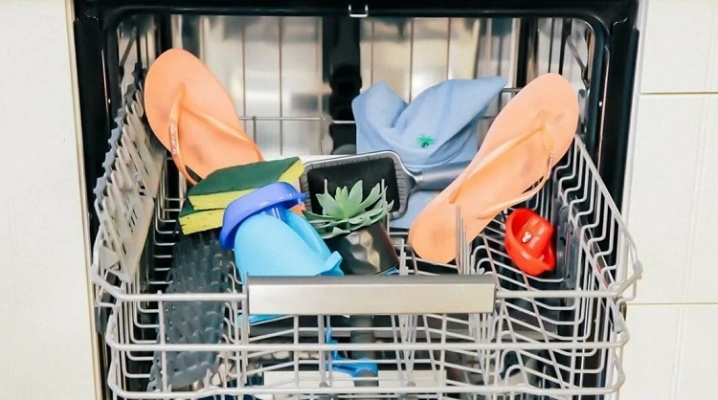
In household appliances such as a dishwasher, it is possible to set different temperature conditions for washing. Therefore, for certain dishes, you can choose a temperature that will not harm it.
Don't forget to take care of your dishwasher after use. The filters must be rinsed with running water to remove food debris, add salt and rinse aid in time. If all the requirements are met, the dishwasher will last a long time and will delight with high-quality washed dishes.















The comment was sent successfully.